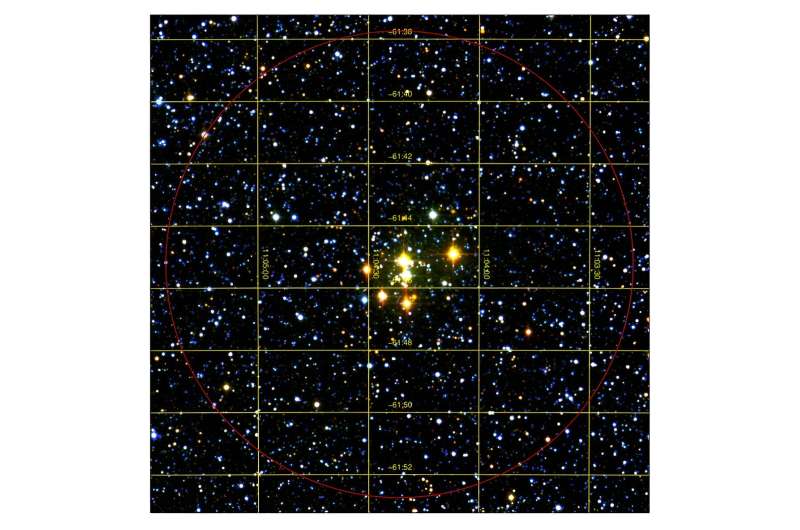
August 6, 2024 by Tomasz Nowakowski , Phys.org
Collected at: https://phys.org/news/2024-08-astronomers-supergiant-rich-stellar-cluster.html
Astronomers report the discovery of a new galactic stellar cluster located some 24,000 light years away. The newfound cluster, which received the designation Barbá 2, turns out to host at least several supergiant stars. The finding was detailed in a research paper published July 30 on the arXiv preprint server.
In general, star clusters are groups of stars sharing a common origin and gravitationally bound for some length of time. Detecting and studying new star clusters may improve our understanding of how stars form and evolve.
Barbá 2 was first identified a decade ago by Chilean astronomer Rodolfo Barbá. He was scanning the plane of the Milky Way using multi-wavelength surveys and looking for stellar clustering, possibly associated with warm dust. As a result, he detected a significant cluster between globular cluster NGC 3603 and the region of ionized atomic hydrogen (HII region) known as Gum 35, with seven bright stars and no warm dust associated.
However, Rodolfo Barbá passed away in 2021 and the results for the identified cluster were never published, until now. The new study published by Jesús Maíz Apellániz of the Astrobiology Center in Madrid, Spain, and Ignacio Negueruela of the University of Alicante in Alicante, Spain, presents the results of new analysis, complemented by data from ESA’s Gaia satellite, confirming the discovery.
“We present a new supergiant-rich stellar cluster hidden by extinction and christen it as Barbá 2, in honor of its discoverer, Rodolfo Barbá […] As Rodolfo was an active participant in the Villafranca project to identify and characterize Galactic OB stellar groups, we add Barbá 2 to that project and we assign it the catalog name Villafranca B-006,” the scientists wrote in the paper.
The study found that Barbá 2 has a core radius of 2.74 light years and is located about 24,100 light years away. The astronomers managed to identify 201 of the most probable members of Barbá 2, concentrated near the cluster’s core. They noted that 53 of them are likely contaminants or belong to an extended population.
According to the paper, the brightest star in Barbá 2 is a yellow supergiant. Besides this star, six other supergiants were detected in the cluster: five red and one blue supergiant. Therefore, Barbá 2 was classified as a supergiant-rich stellar cluster.
Furthermore, the study found that Barbá 2 does not show strong internal motions in the plane of the sky, is not expanding, and does not include a significant number of runaway stars in the field.
Given that still very little is known about the properties of Barbá 2, follow-up observations are required in order to shed more light on the nature of this cluster.
More information: J. Maíz Apellániz et al, Barbá 2: A new supergiant-rich Galactic stellar cluster, arXiv (2024). DOI: 10.48550/arxiv.2407.20812
Journal information: arXiv

Leave a Reply